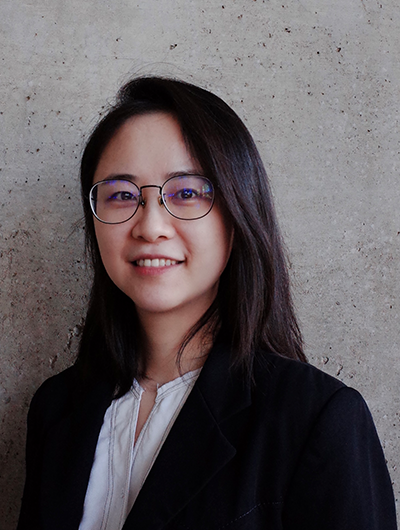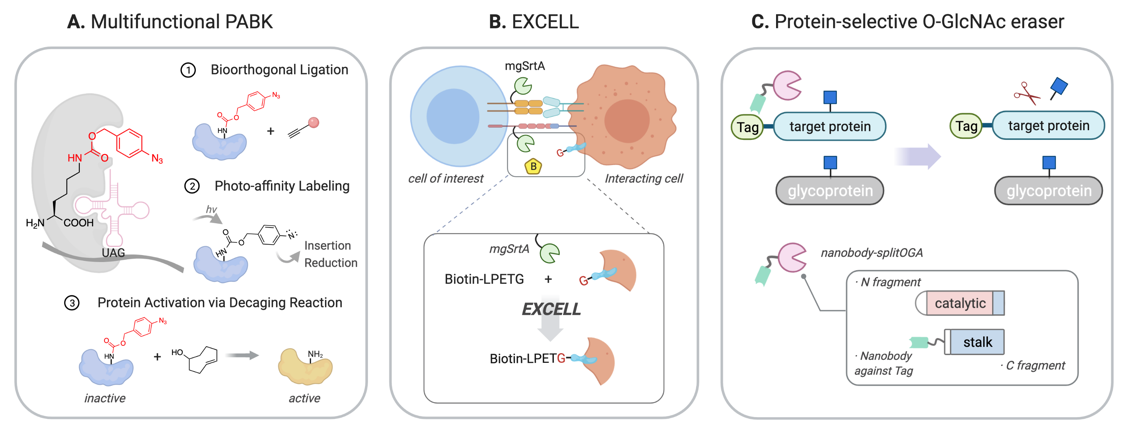
Ge, Yun
葛韵
Institute of Chemical Biology
Junior Principal Investigator
geyun@szbl.ac.cn
Timeline
-
2022 - Present
Shenzhen Bay Laboratory Junior Principal Investigator
-
2018 – 2021
Department of Chemistry and Chemical Biology, Harvard University Postdoctoral Fellow
-
2013 – 2018
Peking University Ph.D. in Chemical Biology
-
2009 – 2013
Xiamen University B.Sc. in Chemistry
Research Areas
The research interests of our group focus on the development of chemical biology approaches for functional analyses and precise modulations of proteins and cells via engineering, in order to deepen the understandings of biological processes and spark the discovery of drugs and therapeutics. We will put our efforts on 1) expanding the repertoire of functionalized proteins, such as nanobodies, with diverse targets and properties, 2) developing chemical biology tools for the regulations of post-translational modifications, and 3) devising approaches for cell surface engineering and cell interactome profiling.
Highlights
Dr. Ge obtained her Ph.D. in Chemical Biology at Peking University in 2018. During her Ph.D. training, she focused on the development and applications of the genetic code expansion technique, bioorthogonal chemistries and enzymatic protein labeling strategies. She has developed a multifunctional unnatural amino acid for protein activation via a bioorthogonal cleavage reaction, and an enzyme-mediated intercellular proximity labeling for detecting cell–cell interactions. Since 2018, Dr. Ge conducted her postdoc research at the Department of Chemistry and Chemical Biology, Harvard University, focusing on the study of O-GlcNAcylation, one of the ubiquitous glycan modifications on proteins. She developed the first protein-selective O-GlcNAc “eraser”, nanobody-splitOGA, by leveraging the blossoming nanobody platform and the structure-guided protein engineering, which has been on the list of most desired tools in the community for years. This tool has already drawn tremendous attention in the glycan and broader community and been widely reported. To date, Dr. Ge has published more than 10 papers on the top ranked journals, including Nature Chemical Biology, Journal of the American Chemical Society, Angewandte Chemie, Chemical Science, and has filed 3 patents.

The chemical biology toolkit for protein modulations and cell interactome profiling.
Honors
2018 Outstanding Graduates Award, Peking University
2017 CHINA National Scholarship for Graduates
2016 Tang Aoqing Chemistry Scholarship
2013 – 2015 Presidential Fellowship for Ph.D. Students, Peking University
Related News
1. New tool to dissect the "undruggable"
2. Nat Chem Biol | 葛韵等开发新型蛋白质选择性O-GlcNAc修饰擦除工具
3. New labeling method can reveal cell-cell interactions
Selected Publications
1. Ge, Y.; Ramirez, D. H.; Yang, B.; D’Souza, A. K.; Aonbangkhen, C.; Wong, S.; Woo, C. M., Target protein deglycosylation in living cells by a nanobody-fused split O-GlcNAcase. Nature Chemical Biology 2021, 17 (5), 593-600.
2. Ge, Y.#; Chen, L.#; Liu, S.; Zhao, J.; Zhang, H.; Chen, P. R., Enzyme-mediated intercellular proximity labeling for detecting cell-cell interactions. Journal of the American Chemical Society 2019, 141 (5), 1833-1837. # contributed equally.
3. Liu, Y.#; Ge, Y.#; Zeng, R.#; Ngai, W. S.; Fan, X.*; Chen, P. R.*, Proximity Chemistry in Living Systems. CCS Chemistry 2023, 5, 1-12. DOI: 10.31635/ccschem.023.202202593. # contributed equally.
4. Ge, Y.*; Lu, H.; Yang, B.; Woo, C. M.* Small Molecule-Activated O-GlcNAcase for Spatiotemporal Removal of O-GlcNAc in Live Cells. ACS Chemical Biology 2023, 18 (1), 193-201. Co-corresponding author.
5. Ge, Y.#; Fan, X.#; Chen, P. R., A genetically encoded multifunctional unnatural amino acid for versatile protein manipulations in living cells. Chemical Science 2016, 7 (12), 7055-7060. # contributed equally.
6. Ge, Y.; Woo, C. M., Writing and erasing O-GlcNAc from target proteins in cells. Biochemical Society Transactions 2021, 49 (6), 2891-2901.












